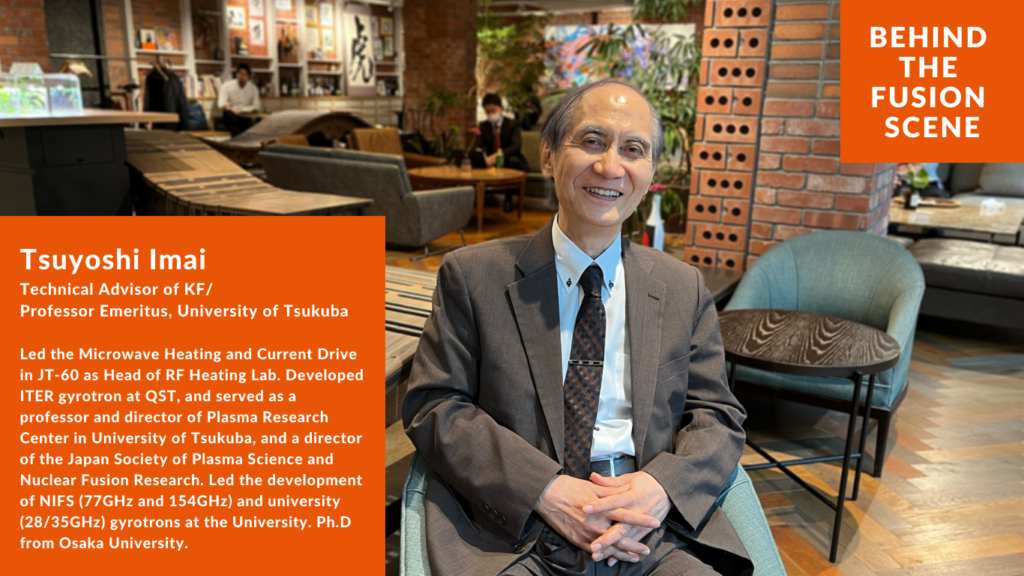
Tsuyoshi Imai, Technical Advisor of Kyoto Fusioneering/Professor Emeritus of University of Tsukuba
Led the Microwave Heating and Current Drive in JT-60 as Head of RF Heating Lab. Developed ITER gyrotron at QST, and served as a professor and director of Plasma Research Center in University of Tsukuba, and a director of the Japan Society of Plasma Science and Nuclear Fusion Research. Led the development of NIFS (77GHz and 154GHz) and university (28/35GHz) gyrotrons at the University. Ph.D from Osaka University.
What made you interested in this industry?
Although I was vaguely interested in the field of science when I was in high school, I had not decided what exactly I wanted to do. However, I was interested in the energy and food industry, and I personally thought that if there was a possibility for Japan to provide its own energy if we tried hard enough, although it is surrounded by sea, we should make an effort to do so. Especially since I thought that energy would solve the problem of food production/supply. At that time, I learned about nuclear fusion in a high school class and thought this was Japan’s opportunity for energy independence, so I started learning about nuclear fusion in college.
When I graduated from university, just as research on nuclear fusion was becoming active in Japan, I joined the National Institutes for Quantum Science and Technology (hereafter referred to as QST, formerly JAERI). I spent the next just under 30 years at QST, where I was involved in various projects that were advanced at the time, such as the construction of the JT60 microwave plasma heating system and the development of the ITER gyrotron. Later, at the University of Tsukuba, I was involved in the research and development of gyrotrons for use in the National Institute for Fusion Science (NIFS) and university institutes, retiring in 2017, and here I am today. For more than 40 years, I have been consistently engaged in research, development, and experiments related to microwave plasma heating and its project management.
Is there any experience particularly memorable for you in your long career?
There are several, but to list just one, the JT60 microwave current drive experiment is impressive. The project was being carried out with considerable effort and funding at the time, but when microwaves were injected into the Tokamak plasma, the plasma current flowed only to a degree that was well below the theoretically anticipated value.
We had to pursue the cause of the problem, but we could not disassemble the assembled equipment. Taking advantage of my understanding of the whole microwave heating system and the experiment, I first attempted a detailed analysis while actually emitting a small amount of microwaves to verify whether the equipment was producing the microwaves as expected. The microwave-radiating antenna consisted of 32 aperture waveguides. I hypothesized that if the vacuum radiation was not reflecting as theoretically expected, that was the cause, and took data while gradually inserting microwaves into the waveguide.
Then I noticed that the phase of the microwaves in half of the waveguides was the opposite of what I had expected, and this time I thought about why this happened by looking over the drawings and looking at the entire device. Then I found a part that I thought might be here, and when I checked it, I found that the part was attached in the opposite way. I still can vividly remember the mixed feelings of relief and accomplishment I felt when, as a result of correcting the problem, the microwaves produced a mega-ampere-class plasma current, as I had hoped. Even project stakeholders at the time were surprised, saying they thought it would not flow.
I was once told by a colleague of QST that I was tenacious. This experience was a strong original experience that led me to persistently pursue the cause of the problem in my subsequent research and experiments, believing that “if I look for the cause without giving up, I will find it”.
What are your aspirations for the realization of nuclear fusion?
As a researcher/engineer, I am partly attracted to the idea of creating a sun on earth. But I also feel that nuclear fusion, a power generation technology that uses lithium, which is abundantly available from the sea, is a clean and safe method that is attractive to Japan, an isolated island nation. I think this is the best technology for Japan, partly because of the availability of omnipresent fuel resources.
I feel that the environmental benefits of contributing to decarbonization are attracting more attention than the power generation aspect these days, compared to when I first became involved in fusion. Still, the fact that this is the technology that Japan can provide for its own needs is connected to my motivation for choosing this path. I feel that I have been involved in this area for a long time because I believe that what I am doing will be useful for the realization of nuclear fusion.
What do you think are the challenges to achieving fusion at this point?
For commercial reactors, I feel it is important to improve the blanket and divertor. As a premise, the materials is an area that inevitably takes time to research. Given the considerable level of research and development that has been done to date, I believe that it would be possible to build a reactor with current technology for a short lifetime. On the other hand, I recognize that further research on materials is needed to create a commercial reactor that can be used for a long time.
What do you think are the future challenges in the gyrotron area?
I think the challenge for the future in the gyrotron area is how to increase the power that can be produced per single gyrotron. Even the DEMO reactor for the STEP project promoted by the UK government is expected to require 300 to 400 gyrotrons with the current gyrotrons, but if the output for each gyrotron can be increased, the target heating could be achieved with a smaller number of gyrotrons.
What are your expectations for Kyoto Fusioneering?
I expect KF to lead the fusion industry in Japan. When I heard Prof. Konishi (CTO of KF) give a lecture in the past, I realized how advanced the industry’s fusion efforts are in the world. Until I heard the lecture, I thought that the realization of fusion would still take a long time and that it would be too early for the private sector to work on it, but I feel that the UK in particular is very dynamic, both in the public and private sectors, and is approaching the realization of fusion much faster than I had imagined. In particular, some private companies have released significant advances in data this year, which would have been unthinkable before.
In this context, gyrotrons will become a base for KF to leap forward. Last year KF won a contract from UKAEA*, and I believe that in the future, the first step will be to successfully deliver the gyrotron to UKAEA and establish a track record. This will be a stepping stone to further progress, at which point the world will take notice of KF. I am also very pleased that the developments I have been involved in will go global. I would like to continue to work hard on the development of the gyrotrons, through collaboration between the University of Tsukuba and KF and other related things.
Expectations for young engineers and researchers in the fusion industry
Research and development towards nuclear fusion is a world where “what we thought should happen theoretically does not work at all as expected when we experiment”. At such times, please do not give up immediately, but persistently pursue the cause and challenge yourself to see how it can be achieved in the same way as the theory. On the other hand, it is also necessary to be calm enough to look at things from a bird’s eye view and reassess them, so I would like for them to work hard towards the realization of nuclear fusion, while mixing passion and calmness well.
■For further information, please visit our recruitment page.
■Past Behind the Fusion Scene can be found here.




